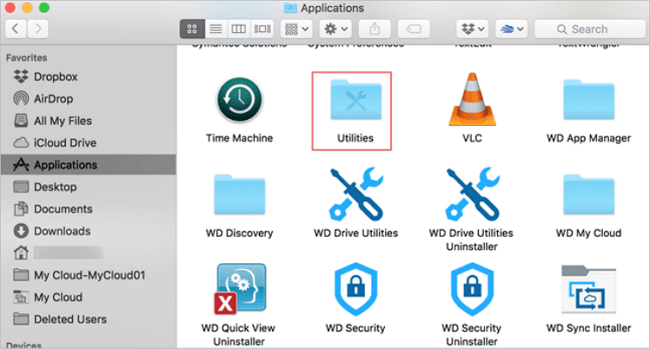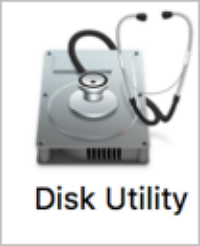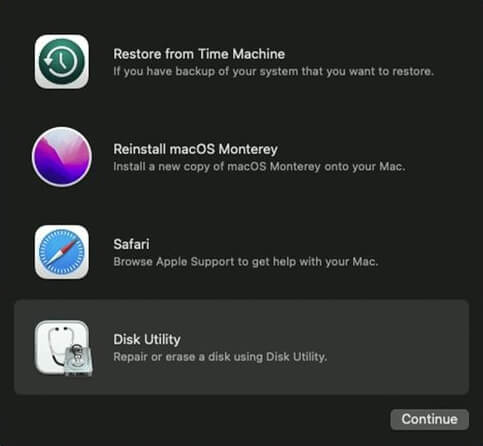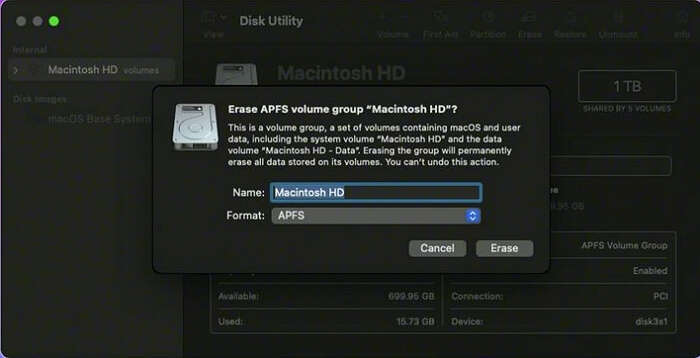[2 Ways] How to Boot Mac into Disk Utility/Recovery Mode with Mac Startup Keys
| Workable Solutions | Step-by-step Troubleshooting |
|---|---|
| 1. Open Disk Utility on Mac |
|
| 2. Boot Mac into Disk Utility |
|
What is Disk Utility on Mac? Disk Utility is a Mac storage manager that can help Mac users manage partitions on Mac. It also can erase or repair the startup disk, solve the USB flash drive not showing up on Mac, add new hard drives, and so on.
Disk Utility is a handy tool, and you can boot Mac into Disk Utility/Recovery Mode with two methods. Let us find out the two methods together.
How to Boot Mac into Disk Utility/Recovery Mode [2 Ways]
When you encounter disk issues, it is lucky that your Mac can still start normally. Sometimes you are sadly found it is not possible to boot up your Mac. We will introduce two methods to boot Mac into Disk Utility.
Method 1. Open Disk Utility on a Working Mac
When your Mac can start up normally, you need to open Disk Utility by searching it with Spotlight, or you can use the Finder to open Disk Utility.
Step 1. Open the Finder on Mac.
Step 2. Go to the Applications menu, and click "Utilities".

Step 3. Scroll down, and you will find the Disk Utility.

Method 2. Boot Mac into Disk Utility/Recovery Mode with Startup Keys
Sometimes your Mac is stuck on Apple Logo, and the startup interface for a long time or fails to boot. Boot Mac into Disk Utility with Mac startup keys may help you solve the problem. Apple silicon Mac and Intel-based Mac have different startup keys. Let us keep reading to learn more.
For Apple Silicon Mac:
Step 1. Make sure your Mac is shut down. Hold the Mac power button until the Recovery Mode appears on the screen.
Step 2. Click the "Disk Utility", and your Mac will enter the Disk Utility successfully.

For Intel-based Mac:
Step 1. Make sure your Mac is shut down. Hold the Command and R keys and release them when you see the Recovery Mode.

Step 2. Click the "Disk Utility", and your Mac will enter the Disk Utility successfully.
How to Fix Mac Won't Boot into Disk Utility/Recovery Mode
Sometimes your Command and R keys are not working, and your Mac won't boot into Recovery Mode, or your Mac cannot boot. How to fix a problem like that?
- Fix 1. Check the keyboard connection on Mac.
- Fix 2. Create a macOS Ventura bootable USB.
- Fix 3. Boot Mac into Safe Mode.
- Fix 4. Reset NVRAM/PRAM
- Fix 5. Boot into Recovery Mode once again.
- Fix 6. Use Mac Internet Recovery Mode
How to Erase and Repair Startup Disk with Disk Utility
When your Mac's startup disk is not performing well, or you encounter Mac no startup disk issues. You can use Disk Utility to repair and fix the problem.
How to Repair Startup Disk with Disk Utility on Mac
We have taught you how to boot your Mac into Disk Utility. Choose one of the methods to go to the Disk Utility menu.
Step 1. Select the startup disk, and it is normally named Macintosh HD.
Step 2. Click the "First Aid".
Step 3. You can repair the startup disk by clicking the Run button.

How to Erase Startup Disk with Disk Utility on Mac
You can boot Mac into Disk Utility with startup keys and erase the startup disk. When you factory reset macOS, you will need to erase the startup disk and reinstall the macOS base system.
Step 1. Select the startup disk, and it is normally named Macintosh HD.
Step 2. Click the Erase button to erase Macintosh HD data.

Recover Data After Erase the Startup Disk with Software
After repairing or erasing the startup disk on Mac to factory reset Mac or reinstall macOS, you may lose essential data. Don't panic! You can recover files after factory reset Mac. How to recover lost files on Mac?
Deep Data Recovery for Mac is designed to recover deleted files on Mac. You can recover data with this professional and reliable tool after upgrading to the latest version of macOS, reinstalling macOS, macOS crash, accidental deletion, and other situations.
This tool can help you recover files in different formats: DOC, XLS, AVI, MOV, AIF, AAC, CR2, RAW, JPG, etc. No matter what kinds of files you lose, we can help you get them back from SD cards, USB flash drives, SDHC cards, memory cards, cameras, and other storage devices.
How to recover data with Qiling Data Recovery for Mac? Check the detailed method below:
Step 1. Select file types
Launch Deep Data Recovery for Mac. Select file types and click "Next" to start

Step 2. Search for lost files
Select the disk location to search for lost files (it can be an internal HDD/SSD or an external hard drive) where you lost data and files. Click the "Search for lost files" button.

Step 3. Go through the scanning results
This software will immediately scan your selected disk volume and display pictures, documents, audio, videos, and emails on the left pane.

Step 4. Select the file(s) and recover
Click the data to preview, and click the "Recover" button to have them back.
Summary
After reading this passage, you have learned what Disk Utility is on Mac and how to boot Mac into Disk Utility/Recovery mode in normal ways and with Mac startup keys. You also know how to repair and wipe the startup disk with Disk Utility and recover data with Deep Data Recovery for Mac. If you have more questions about booting Mac into Disk Utility, you can keep reading the last part.
Boot Mac into Disk Utility FAQs
This part will display four additional questions and answers about booting Mac into Disk Utility.
How do I factory reset my MacBook Pro with Disk Utility?
You can factory reset MacBook Pro by booting MacBook Pro into Recovery Mode.
- 1. Click the Apple icon and shut down the MacBook Pro.
- 2. Turn on the MacBook Pro, and hold the power button or Command + R keys until you see the Recovery Mode.
- 3. Select "Disk Utility".
- 4. Erase Macintosh HD and quit Disk Utility.
- 5. Reinstall macOS and turn on your Mac.
What can I do if my Command + R keys not working on Mac?
Your Intel-based Mac will not boot into the Recovery Mode if your Command + R keys are not working. How to fix this problem?
- 1. Check the keyboard connection on Mac.
- 2. Create a macOS Ventura bootable USB.
- 3. Boot Mac into Safe Mode.
- 4. Reset NVRAM/PRAM
- 5. Boot into Recovery Mode once again.
- 6. Use Mac Internet Recovery Mode
How to repair a Mac startup disk with Disk Utility?
You can open Disk Utility by searching in Mac Spotlight or using the startup keys to boot your Mac into Disk Utility.
- 1. Choose the startup disk called Macintosh HD.
- 2. Choose "First Aid" and click "Run" to repair the Mac startup disk.
How do I start my Mac in Disk Utility?
If your Mac is running well, you can turn on Mac and search the Disk Utility in Spotlight. Or you can run Finder, go to the Applications, click "Utilities", and you can find the Disk Utility. If your Mac cannot boot normally, you should turn off the Mac and hold the power button or the Command + R keys until you see the Recovery Mode. Then you can click the Disk Utility.
Related Articles
- (Solved!) How to Backup Gmail Emails with Attachments for Windows 11/10/8/7
- How to Fix macOS Ventura WindowServer Prevents from Sleeping [10 Available Solutions]
- Install IDE Hard Drive
- How to Fix Windows 10 Stuck at Getting Files Ready for Installation